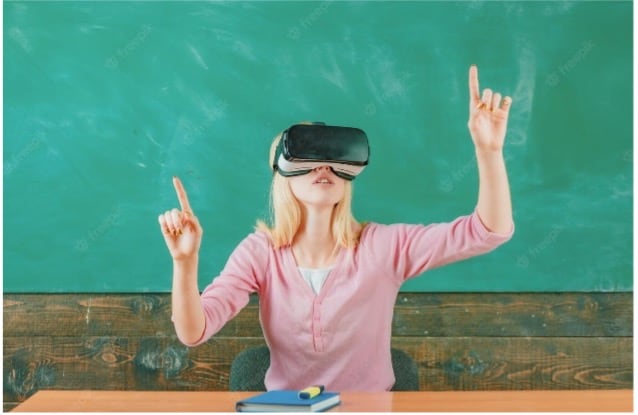As technology evolves, bringing us new immersive and imaginative worlds, we must adapt how we educate children and equip teachers to face these new challenges. When education lags technological advancements, technology, not educators, determines what qualifies as an educational opportunity. While the metaverse infrastructure is still being built, educators, politicians, and digital designers have the opportunity to lead the way rather than get swept up in the current. We need innovative techniques to integrate the actual world with augmented and virtual reality (VR) experiences to fully realize the metaverse’s promise as a 3D, interconnected, immersive, and real time online space. As a result, instructors are increasingly showing interest in employing virtual reality to enhance scientific education to take use of the newest in 3D technology.

Virtual reality requires the usage of a computer-connected headset. On a screen within the headset, three-dimensional visuals are projected, and users may move around the virtual world by using a joystick or juts twisting their hands.
Although the equipment required to employ virtual reality technology in the classroom can be costly, David Evans, executive director of the National Science Teachers Association, believes that prices will soon fall, and virtual reality will become a standard in science classrooms [1].
Richard Lamb who is the professor and director of the Neurocognition Science Laboratory states ‘We have this participatory, genuine, authentic classroom environment that allows teachers to practice their teaching’’ [2]. While Lamb is clear that virtual reality training should not replace actual classroom experience, he believes technology may help pre-service teachers gain confidence by preparing them for realistic classroom scenarios. As Lamb argues, virtual reality simulations are far more realistic than teachers then say watching a video. ‘We found that the way we biologically respond to the virtual world is extremely like how we respond to the actual activities in our virtual reality studies’’. In these circumstances, he claims, instructors feel anxiety, stomach tightness, and an elevated pulse rate, just as they would in a real classroom. In conclusion, according to Lamb, the ultimate purpose of employing virtual reality in education is to provide instructors with more experience and training, resulting in better educational experiences for students.
Another example of teacher who uses virtual reality in her classroom is Tammy Dunbar who is a 5th grade teacher at Lincoln Elementary School [3]. Dunbar says that in the classroom she has found this technology to be useful. She observed the performance of her students before and after using virtual reality in her lessons and observed that the use of virtual reality helped students to concentrate more easily, and also their exam results were better.
Lastly, Second Life is a free online virtual environment which works by using VR. The Berkman Center at Harvard University owns the private island Berkman in Second Life, which is used to host in-world conventions. Professors Charles and Rebecca Nelson of Harvard Law School utilize Berkman Island as a novel instructional environment [4]. According to Yellowlees and Cook, Second Life’s simple accessibility for anybody with a computer and an internet connection is a significant benefit since it allows many individuals to engage in instructional 3D visual environments [5].
The aim of VRLab Academy is to provide a more interactive educational environment for both students and teachers about biology, physics, chemistry, and natural sciences by using virtual reality technology. Based on these thoughts, it is possible for teachers to leverage virtual reality in different ways depending on their educational goals. Even though educators are just beginning to explore the possibilities of virtual reality, technology will continue to improve, and learning options will continue to expand. Virtual reality education may soon become a mainstream need for new or specialized teachers.
Take a look at all experiments at VRLab Academy and enhance your teaching power with us.
References
[1]. C. Youngblut ‘Educational uses of virtual reality technology’, 1998.
[2]. Wendy McMahon, ‘’How Virtual Reality in the Classroom is Providing Training for Teachers’’, 2017.
[3]. Ed Source, ‘Teachers eye potential of virtual reality to enhance science instruction’.
[4]. M. Rymaszweski & M. Wallack, ‘Second Life the Official Guide’, 2007.
[5]. M. Yellowlees & M. Cook, ‘Education about hallucinations using an Internet virtual reality system: A qualitative survey’, 2006.